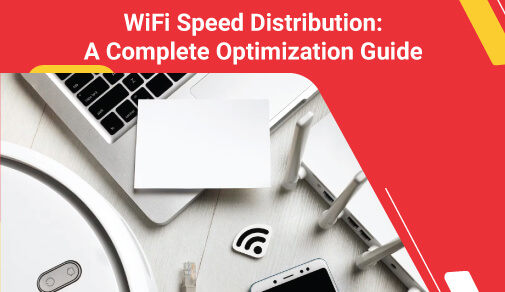Internet Speed of Wifi
-
0
-
-
10 minutes

Division of WiFi internet speed among users is essential to maintain a positive user experience. Users may dominate the bandwidth without fair distribution, leading to slower WiFi speeds for others. This can be difficult when users want to check WiFi speed or perform tasks that require a reliable connection. Fairness means that everyone gets an equal share of the available bandwidth, allowing seamless browsing.
Sharing internet speed among multiple users can come with several challenges. Firstly, different devices connected to the WiFi network may have varying bandwidth requirements. Some users may want to do basic tasks like web browsing, while others may require faster WiFi speeds for streaming or online gaming. Some users may also engage in bandwidth-intensive activities like HD video streaming or large file downloads. This can impact the network performance and limit the internet speed of other Wifi users.
This article addresses the importance of fair internet speed distribution in a WiFi network. Read on to understand how to enhance the WiFi speed and productivity of the WiFi network.
Understanding Internet Speed and Bandwidth
When measuring a connection's quality, it is important to understand the difference between internet speed and bandwidth. These are the two factors that determine the quality of your internet connection.
Internet speed is like the maximum speed limit on a highway. It tells you how fast data can travel on a network. Just like a faster car can move faster, a higher internet speed in Mbps means data can transfer more quickly. This means you can download files faster, stream videos smoothly, and browse the web with less waiting.
On the other hand, bandwidth is like the number of lanes on a highway. It determines how much data can flow at the same time. If there are more lanes, more cars can travel simultaneously. Similarly, higher bandwidth means your internet connection can handle more data at once. Bandwidth is usually measured in Mbps. However, these days with faster connections, Bandwidth is also measured in Gbps.
Factors Affecting Internet Speed
Internet speed can be influenced by various factors, such as:
1. The server hosting the website you're visiting and its internet connection.
2. The routers that handle the data as it travels across the internet before reaching your device.
3. Spyware or other malicious software that can slow down your computer's ability to process data.
4. Problems with your web browser or operating system, which can be caused by corruption or poor quality.
5. Issues with the TCP/IP format, a set of rules governing how data is transmitted over the internet.
6. The speed of your computer's processor, network connection, hard drive, graphics accelerator, and the amount of RAM (Random Access Memory) it has.
7. Using outdated software or misconfigured and overloaded routers.
Factors Affecting Bandwidth
Bandwidth may be affected by multiple factors, including:
1. Upstream and Downstream Bandwidth
When using the internet, data flows in two directions: downstream and upstream. Downstream bandwidth refers to the data flowing to the device, while upstream bandwidth refers to the data flowing from the device. Most internet processes involve more downstream usage than upstream usage, prioritising downstream bandwidth. However, certain activities like large data transfers, remote access, video chats, and voice-over IP calls require more upstream bandwidth.
2. Internet Usage
The number of simultaneous internet tasks performed on a computer can affect the WiFi speed. As users increase the number of functions, the data requirements of downstream usage approach the maximum available bandwidth. This slows down each task. Users can serialise tasks instead of performing them simultaneously to optimise bandwidth usage.
3. Background Internet Usage
Automatic updates from software programs like antivirus programs or operating system updates can consume background bandwidth without the user's knowledge. To manage this, users can turn off automatic updates in each program's settings to prevent them from using up their available bandwidth.
4. Multiple Users of a Single Connection
When multiple people use a single internet connection, the available bandwidth is divided among all devices, allocating a smaller portion of bandwidth to each device. This can lead to slower data transfer for all devices. Some router Quality of Service (QoS) settings allow prioritising bandwidth usage for specific devices, granting increased access to the available bandwidth.
5. Wireless Bandwidth
The maximum speed of a wireless internet connection depends on different technological factors. Routers are set up to work with specific wireless protocols like 802.11a, 802.11b, 802.11g, and 802.11n, each with its maximum speed capability. Additionally, how close a device is to the router affects the speed it can experience. Devices closer to the router can have a higher maximum speed compared to those farther away.
Once we understand the factors that can affect Wi-Fi speed and bandwidth, it becomes important to know how to divide the available internet speed among users to ensure everyone gets consistent performance when using the Wi-Fi network.
Steps to Dividing Internet Speed of Wi-Fi Among Users
Listed below are the steps to dividing Wi-Fi speed among users:
1. Evaluate Capacity and Limitations: Assess your network infrastructure, including the router, access points, and Wi-Fi capabilities. Regularly check the Wi-Fi speed using tools like Google Internet speed test to determine the maximum achievable speed and identify any potential bottlenecks or performance issues.
2. Identify Needs and Usage Patterns: Understand the specific needs and usage patterns of Wi-Fi users. Different users have different requirements, ranging from basic web browsing to bandwidth-intensive activities like streaming high-definition videos or online gaming. Conduct surveys or gather user feedback to gain insights into their needs and specify appropriate speed allocations.
3. Prioritize Critical Applications: Not all applications and users have the same level of importance. Prioritise critical applications and users in the network. For businesses, this may include cloud-based services like storage or applications for web browsing and video conferencing, which are essential for daily operations.
4. Implement Quality of Service (QoS): Use Quality of Service (QoS), a network management technique, to efficiently prioritize and allocate network resources. It helps prioritize and distribute network resources in a smart way. Just like a traffic cop directs cars to ease congestion, QoS optimizes performance and reduces delays on your network. It prioritizes tasks according to their importance and gives you a smoother internet experience.
Steps to changing QOS Setting
To change the QOS setting, follow the below-mentioned steps:
Step 1: Start by accessing the router settings page. To do this, open a web browser and enter the manufacturer's default IP address. Once they have entered the IP address, they will be prompted to log in using their username and password.
Step 2: Once logged in, navigate to the Wireless tab within the router settings page. This is where users can make changes to their wireless settings.
Step 3: Look for the QoS Settings. These settings are usually located as a subcategory within the advanced network settings or Wireless Settings section. Users may need to explore different tabs or menus to find them.
Step 4: Locate and click on the Set Up QoS Rule button. QoS Rules allow customised settings that dictate the router's behaviour in prioritising certain types of traffic. By creating rules, users can specify the priority level for different kinds of connections, such as Skype or streaming services.
Step 5: Adding the important networks or applications. A router may display a list of commonly used applications in the main QoS setting tab. Select the desired application if it is already listed.
Step 6: If the application that users want to prioritise is not listed, they can add it by clicking the 'Add Priority Rule' button located at the bottom of the QoS page.
Step 7: Click on 'Apply' to save the settings.
Step 8: Finally, reboot the router under the general settings.
These rules help the router filter and distribute available bandwidth effectively.
3. Incorporating Bandwidth Management Techniques
Bandwidth management mechanisms are important in optimising network performance for all users. They ensure efficient utilisation of available resources. These include various techniques and algorithms, some of which are:
1. Traffic Shaping (Rate Limiting): Traffic shaping, or rate limiting, is a way to control the speed at which data is sent and received on a network. It's like managing how cars move on a road to prevent congestion. In rate limiting, we use techniques such as token bucket and leaky bucket algorithms to control how much data can flow at a given time. Think of it as using a bucket with tokens or small holes to regulate how much water can pass through. We also adjust something called TCP rate control, which is like a traffic cop, to regulate the flow of data and have better control over how it's transmitted. With Traffic shaping, we can ensure the network doesn't get overwhelmed and data can be sent and received smoothly.
2. Scheduling Algorithms: Scheduling algorithms are like traffic directors for data packets on a network. They decide the order in which the packets are handled and sent, ensuring everything runs smoothly. Just like a teacher prioritizes students' questions in class, scheduling algorithms prioritize and allocate network bandwidth. They use techniques like Weighted Fair Queuing (WFQ) and Weighted Round Robin (WRR) to determine how much attention each data packet gets based on specific rules or criteria. This way, different types of data, like videos or emails, get fair treatment and don't have to wait too long to be processed.
3. Congestion Avoidance: Congestion avoidance is like preventing a traffic jam on a network. We want to keep the network running smoothly without any slowdowns. To do this, we use techniques like Random Early Detection (RED) and Weighted RED (WRED). It's like having an intelligent system that can selectively drop or mark certain data packets. This helps to prevent the network from getting too crowded and avoids situations where the data storage becomes overwhelmed. Doing this ensures the network stays in good shape and performs well, just like ensuring smooth traffic flow on a road.
4. Explicit Congestion Notification: Explicit Congestion Notification (ECN) is like a warning system for network devices. It allows them to communicate with data senders and tell them if there's a chance of congestion. It's similar to how a driver on the road might see a warning sign about heavy traffic ahead. When network devices receive this notification, they can proactively adjust how fast they send data. This helps to prevent problems that can occur when the network becomes too crowded. It's like slowing down your driving speed when you know a traffic jam ahead.
5. Buffer Tuning: Buffer tuning is like optimizing the storage space within routers. It's about finding the best way to allocate memory in the routers so that it's used efficiently. This helps to reduce the chances of dropping data packets, especially when there's a sudden increase in traffic. It's like rearranging the shelves in a small closet to fit more things without anything falling out. Buffer tuning enables the memory in the routers to be used effectively, and we minimize the chances of losing data packets, even when there's a temporary surge in network traffic.
6. Bandwidth Reservation Protocols: Bandwidth reservation protocols are like special passes for essential applications on a network. They use protocols like RSVP and CR-LDP to make sure that specific applications or traffic flows get the necessary network capacity they need. It's like reserving a particular lane on the highway for a VIP car. These protocols reserve and allocate resources in advance, so important applications can run smoothly and reliably without being slowed down by other traffic. It's like ensuring important tasks get the attention they need, even when a lot is happening on the network.
4. Monitoring and Analysing Traffic
Network monitoring tools play a crucial role in assessing the utilisation of bandwidth within a WiFi network. These tools provide administrators with real-time insights into the traffic flow. By leveraging such tools, administrators can gather data on network performance, identify potential bottlenecks, and make informed decisions regarding bandwidth management.
These decisions may include implementing Quality of Service (QoS) settings, bandwidth allocation strategies, or traffic shaping techniques to ensure fair bandwidth distribution and enhance WiFi speed performance.
Conclusion
Effectively managing and dividing internet speed among users in a WiFi network is crucial for ensuring fair access and optimal performance. Through the implementation of bandwidth management techniques, such as QoS, bandwidth allocation strategies, and traffic monitoring, administrators can distribute bandwidth, minimise congestion and maximise WiFi speed.
A balanced and high-performing WiFi speed can be achieved by evaluating network requirements, identifying bandwidth-intensive applications or users, and configuring appropriate settings on routers. Additionally, network monitoring tools and analysis are vital in identifying usage patterns. They help track bandwidth consumption and enable taking corrective actions when necessary.
Enhance your online experience and enjoy uninterrupted, high-speed internet connectivity by choosing ACT Fibernet. As a renowned service provider, ACT offers reliable and fast internet services that ensure seamless browsing and connectivity. Discover their attractive broadband plans and unlock a world of enhanced online possibilities with ACT Fibernet. For more information visit the ACT website!







